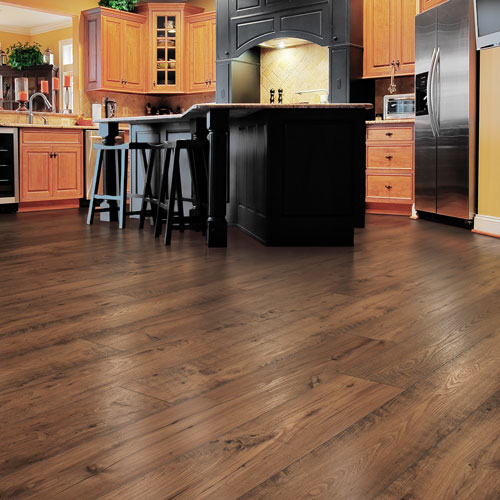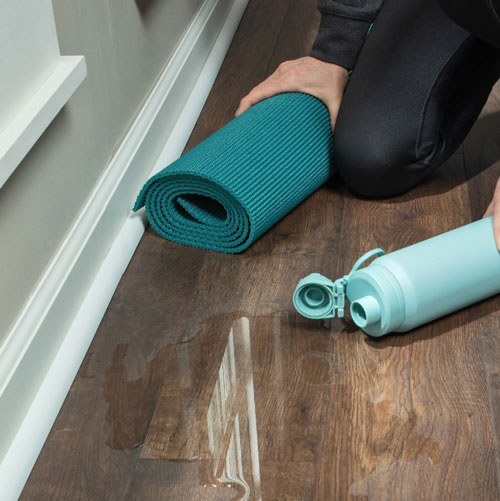Is Laminate the Right Flooring for My Kitchen?
While some flooring types like tile or luxury vinyl are obvious choices for kitchens and others like solid hardwood are not ideal, laminate often falls into a gray area.
Laminate flooring may not be the right choice for every kitchen. But laminate has become a popular choice for kitchen renovations, offering homeowners a balance of affordability, durability, and style. Many are drawn to its practicality and versatility.

Laminate has many advantages and some drawbacks to consider before installing it in your kitchen.
What are the advantages of laminate flooring in a kitchen?
Laminate is a beautiful flooring choice with options that mimic wood, tile, and stone. With laminate, you can easily match any interior design style. In addition to its aesthetics, laminate offers several benefits that make it a compelling choice for kitchens.
- Durability: Laminate flooring is known for its resilience, making it an excellent choice for high-traffic areas like kitchens. Its ability to withstand scratches and dents ensures that your kitchen floor can handle the demands of daily use without showing signs of wear and tear too quickly.
- Water Resistance: Most laminate offers some level of water resistance, making it able to handle everyday spills with ease. Thanks to advances in manufacturing, some laminate options are waterproof, making them perfect for the kitchen.
- Affordability: Compared to hardwood or tile flooring, laminate is typically more cost-effective.
- Easy Maintenance: Laminate is one of the easiest flooring types to clean and maintain. Regularly sweep and occasionally damp mop your laminate to remove any dirt or debris that may scratch its surface.
- Easy Installation: Laminate’s click-and-lock installation is simple and quick, meaning your kitchen won’t be disrupted for long. It is so easy to install that many homeowners can tackle it as a DIY project.

What are the disadvantages of laminate flooring in a kitchen?
There are some drawbacks that should be considered before investing in laminate flooring in your kitchen.
- Susceptibility to Moisture: While laminate flooring is water-resistant to some extent, excessive moisture can still seep into the seams and cause damage over time. Even with waterproof laminate options, you’ll need to ensure proper installation to prevent water damage.
- Limited Lifespan: Compared to some other flooring options like hardwood or tile, laminate flooring typically has a shorter lifespan. The floors may start to show signs of wear and tear, requiring replacement sooner than expected.
- Installation Challenges: While laminate flooring is relatively easy to install, improper installation can lead to issues such as buckling or gaps between planks.
- Sensitivity to Heavy Loads: Laminate flooring may not be as resilient to heavy loads as other flooring materials like tile. Heavy appliances or furniture can cause indentations or damage to the laminate surface, particularly if not adequately supported or protected.
- Limited Repair Options: Unlike hardwood flooring, which can be sanded and refinished to repair minor damage, laminate flooring cannot be refinished. While individual planks can be replaced if damaged, finding an exact match to the existing flooring may be challenging, especially if the product has been discontinued.

What are some tips for choosing the right laminate flooring for my kitchen?
When selecting laminate flooring for your kitchen, consider the following:
- Consider Water Resistance: Opt for laminate flooring with high water resistance or moisture protection features. Look for laminate products specifically designed for wet areas or with waterproof core technology to provide added protection against water damage.
- Choose Durable Finishes: Look for laminate with a durable top layer to withstand everyday wear and tear. A quality wear layer will help protect the laminate from scratches, stains, and fading, ensuring your kitchen floor maintains its appearance over time.
- Assess Style and Design: Select laminate flooring that complements your kitchen’s aesthetic and matches your personal style. With a wide range of colors, patterns, and textures available, you can find laminate that mimics the look of hardwood, tile, or stone to enhance the visual appeal of your kitchen.
- Review Installation Requirements: Ensure proper installation techniques are followed to ensure the longevity and performance of your laminate flooring.
- Check Warranty and Quality: Invest in quality laminate flooring. Look for products backed by warranties that cover defects in material and workmanship, as well as wear and tear under normal residential use.
Laminate flooring is a practical and budget-friendly option for kitchen remodels or renovations. While it offers notable advantages in durability, resistance, and ease of maintenance, potential challenges like moisture susceptibility and limited longevity must be carefully weighed. At Classic Flooring Center, we can help you determine if laminate is right for your kitchen.
